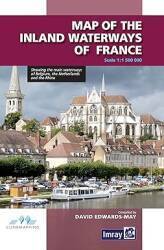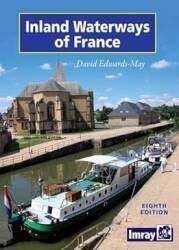
Cour-les-Barres to Nevers
Cour-les-Barres to Nevers
South from Cours-les-Barres
We are on a one-week trip on the
Canal Latéral à la Loire
in central France, traveling 130 kilometers
from Briare to Decize.
We have just spent the night at the small town of
Cour-les-Barres.
Today we will cross the large canal bridge of Guétin
over the Allier river.
The canal turns to the east along with the Loire.
We will pass the small towns of Gimouille and Challuy,
and then turn off the canal into the side channel leading
to the large basin at Nevers.
In Nevers, the largest city on our trip, we will explore
the old city and visit its large and unusual double
cathedral.

Part of map NL-31-5 from the Perry-Castañeda Library Map Collection at the University of Texas at Austin.
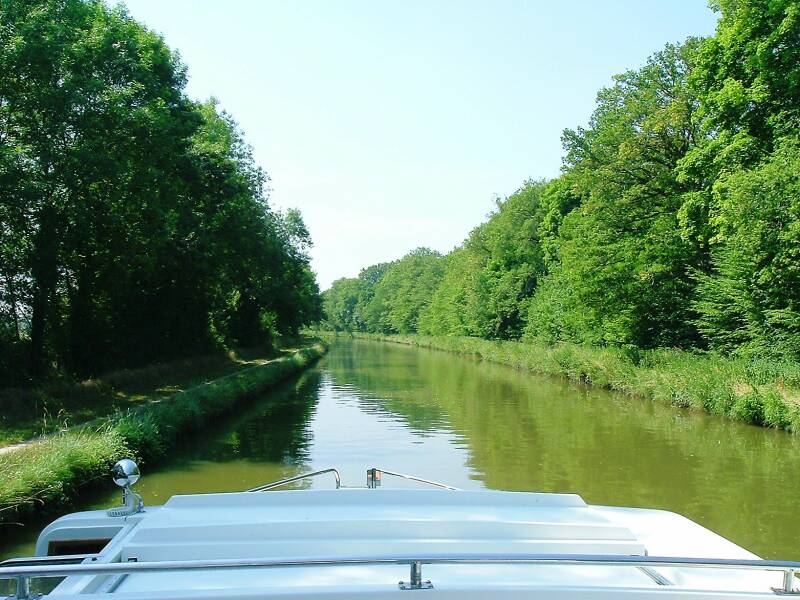
Cuffy
More onCuffy
Cuffy is a town of about 1,100 people. Its name comes from the Low Latin Cofiacus, meaning "the domain of Cofius." Spelling was all over the place in the Middle Ages, it appears as Cufeium, Cufeyacum, Terra Cufiaco, Terra Cufiaco, Cufec, Cufyaco, Cufiaco, Cuphiaco, and Cuphiacum between 1176 and 1297. It is first spelled Cuffy in a record from June 1417.
The village of Guétin, an outlying part of Cuffy, is along the Allier river. The Allier is the largest Loire tributary we encounter on this trip. There are two bridges at Guétin, the highway bridge for the D976 Bourges—Nevers highway, and a high aqueduct bridge the canal crosses.
Guétin
A double lock at Guétin lifts us up to pass over the canal bridge. The lower gates of the lower lock are underneath a roadway bridge. A large commercial barge, the largest size that can fit through locks built to the Freycinet gauge, looks as though it is about to cross the road when it is about to start down in the lower lock.
On the first trip we will tie up along the canal bank below the double lock and walk up to see the locks, cross the canal bridge, and return.
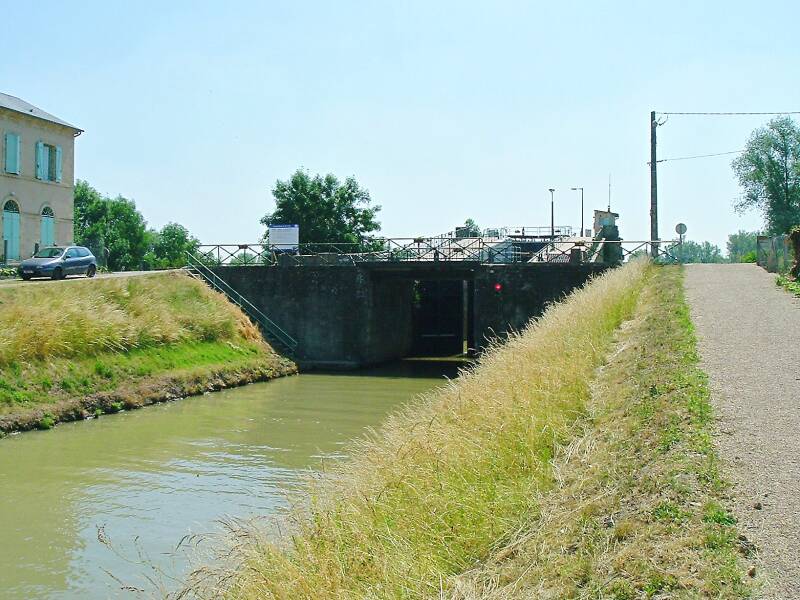
The canal bridge is 343 meters long, plus another 127 meters for the double lock. It crosses the Allier river with 18 stone arches.
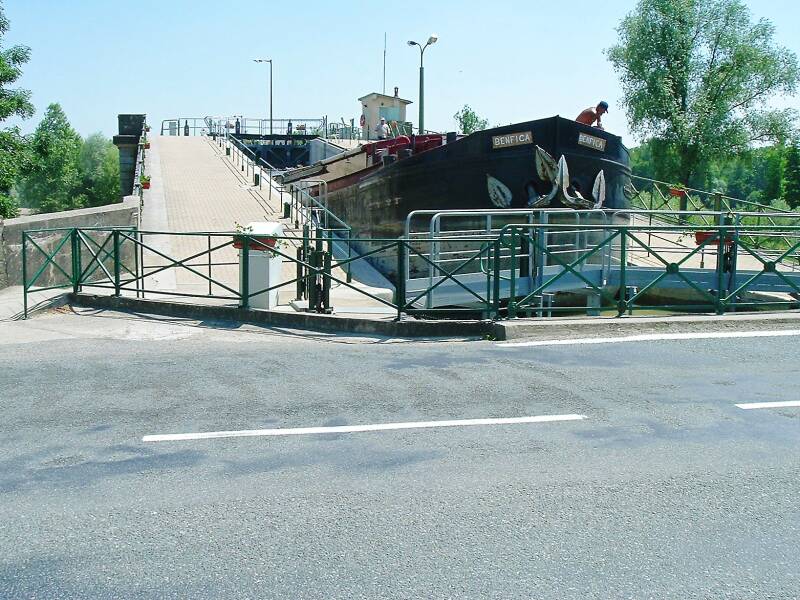
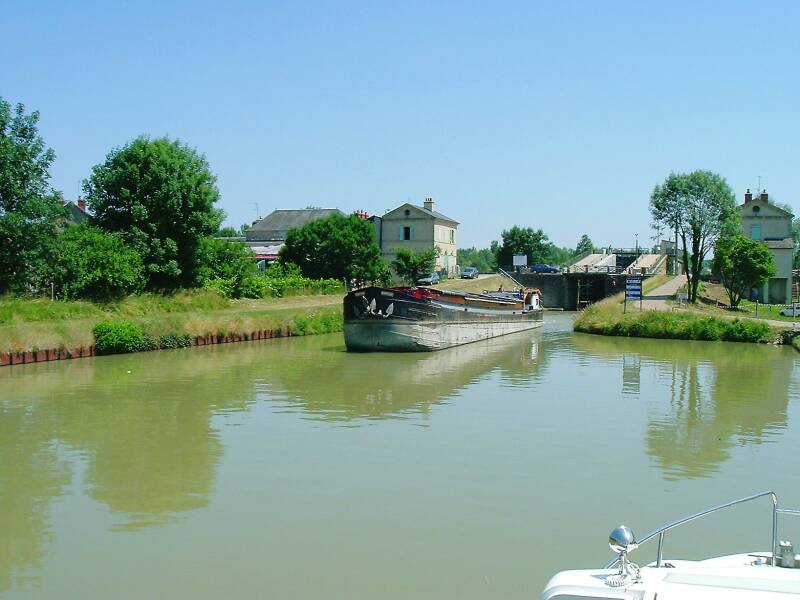
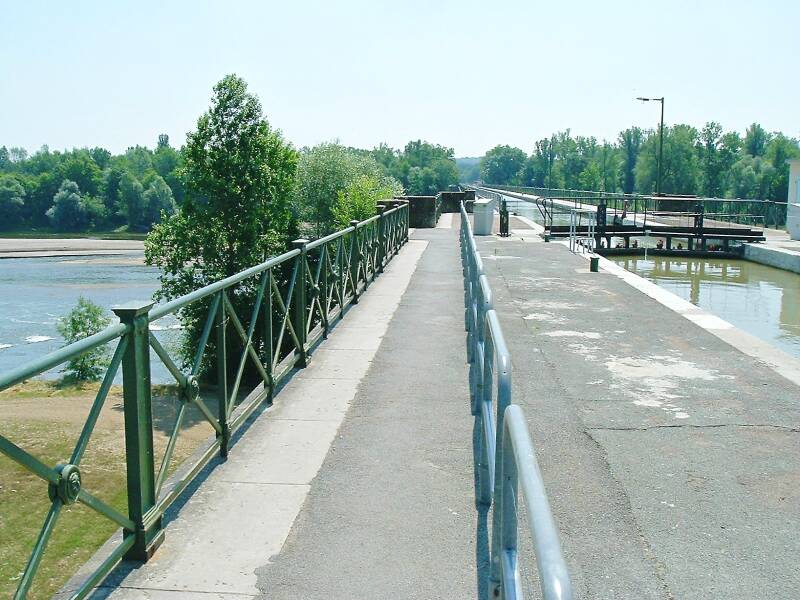
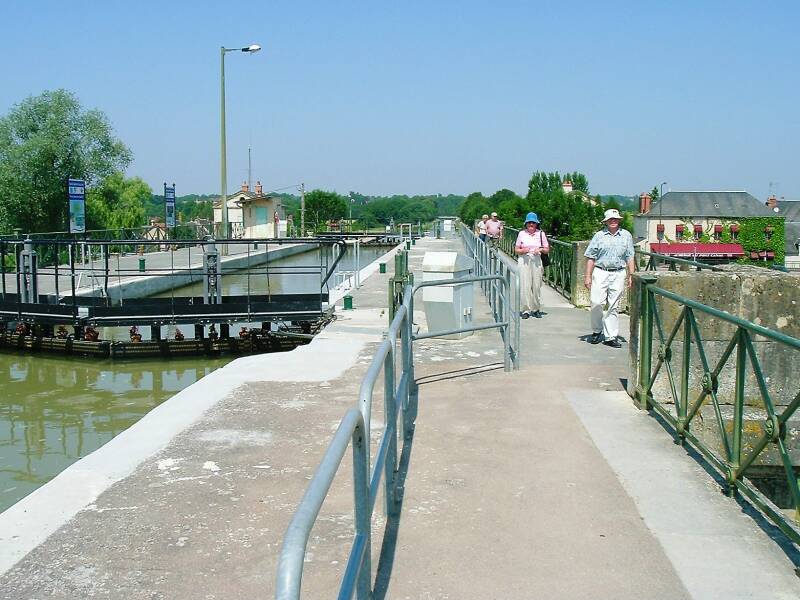
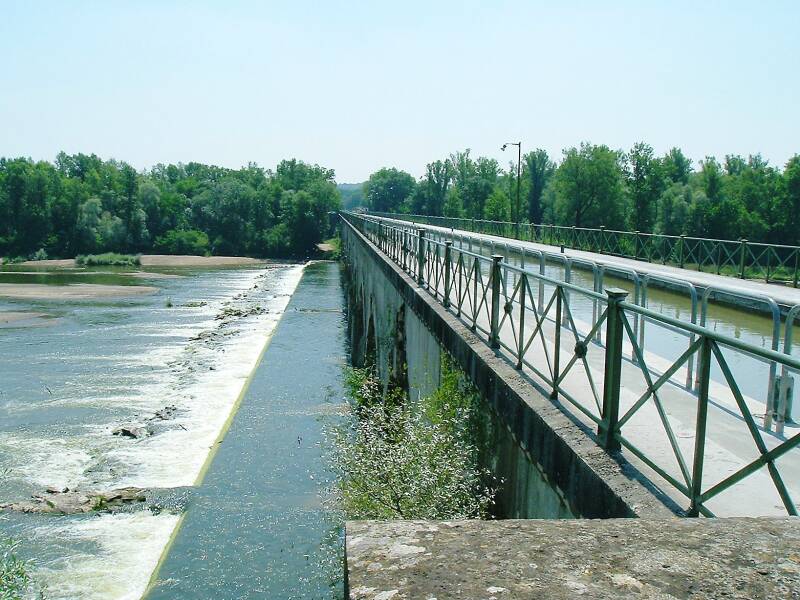

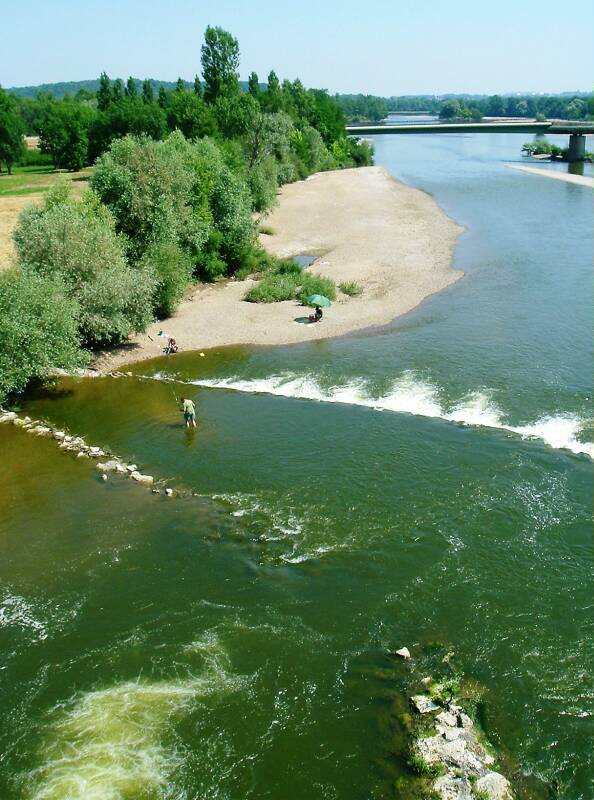

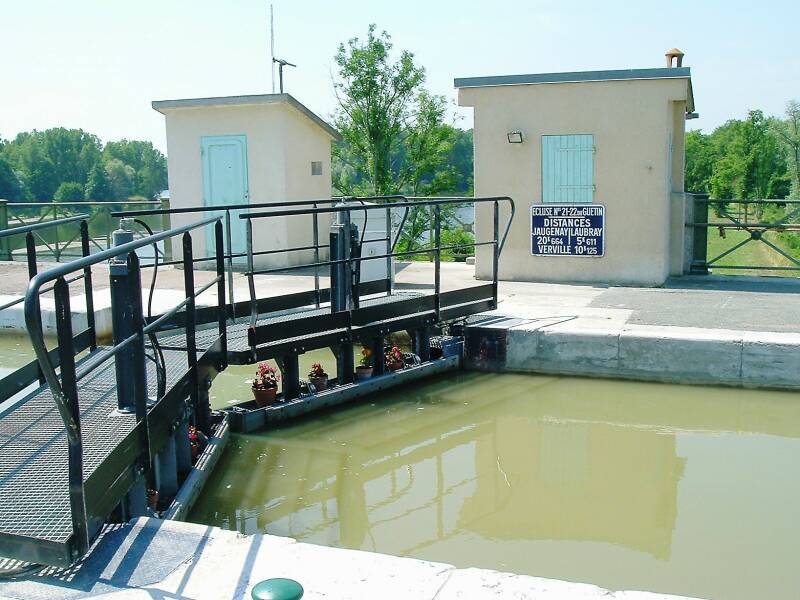
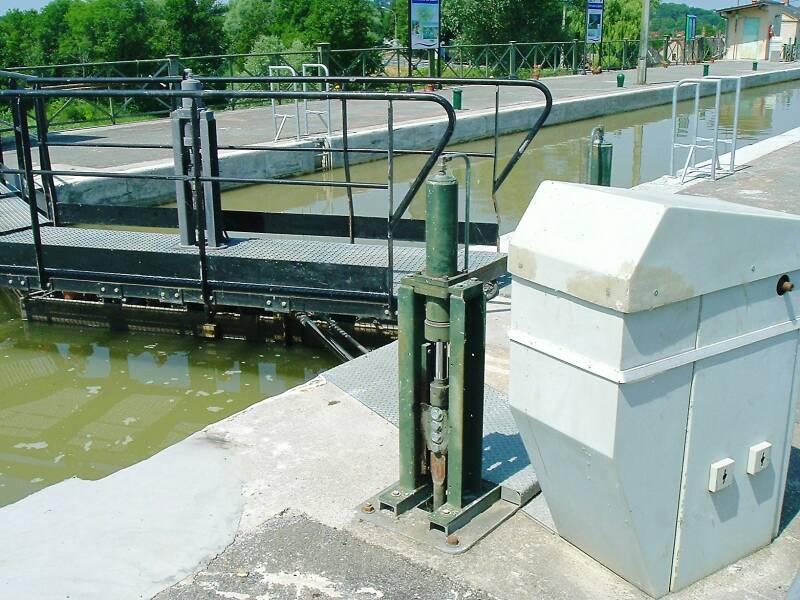
The upper lock is much deeper than any others between Briare and Decize. In its low state you can see the large concrete sill at the upstream end. Going up the sill causes no danger, we will stay back from the gates to avoid the strong flow of water out of the valves at the bottoms of the gates.
Lock sills are a hazard when you are going down. If the stern of your boat is too close to the upper gate as you are lowering, there is a chance that your stern will ground on the sill, damaging your rudder and propellor and possibly damaging your hull.
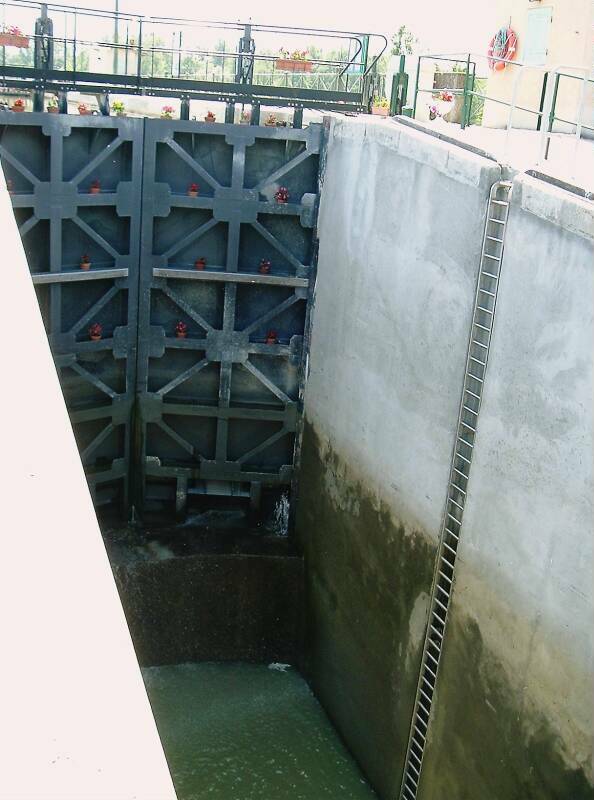
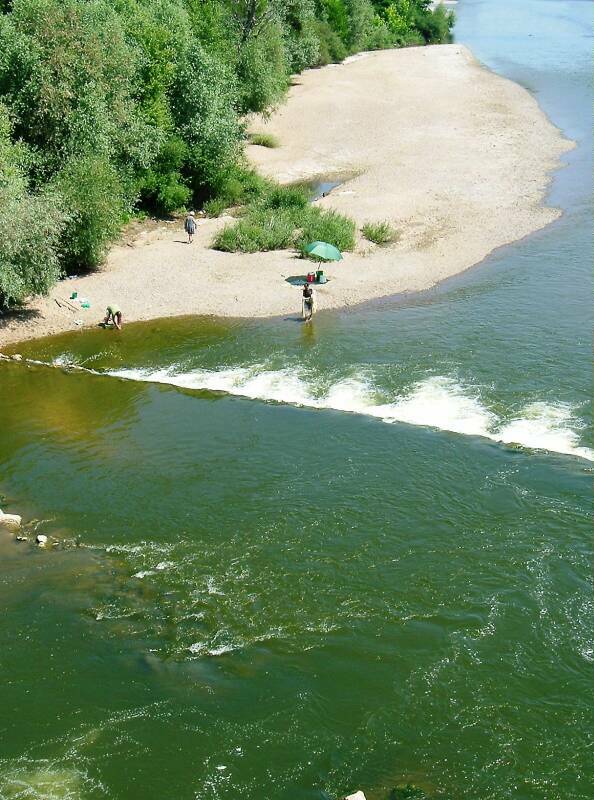

OK, we'll deal with the lock after lunch at the Auberge du Pont Canal.
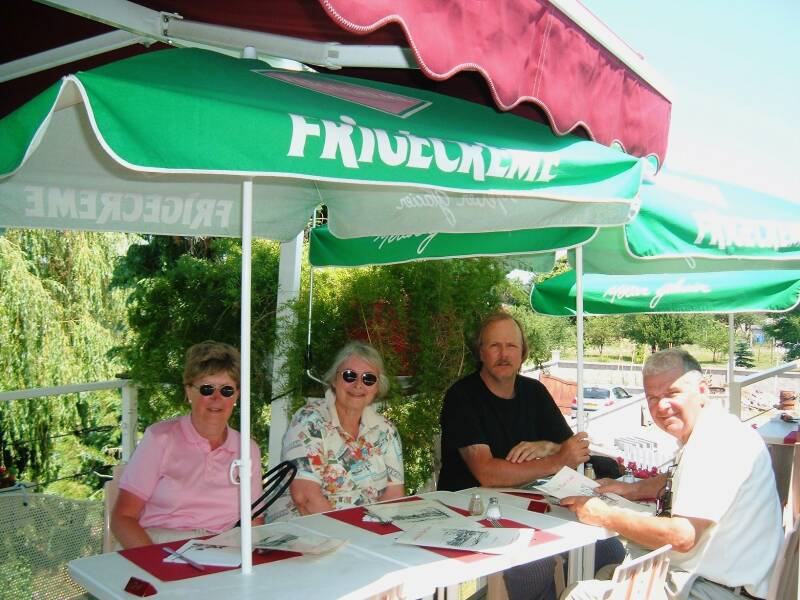
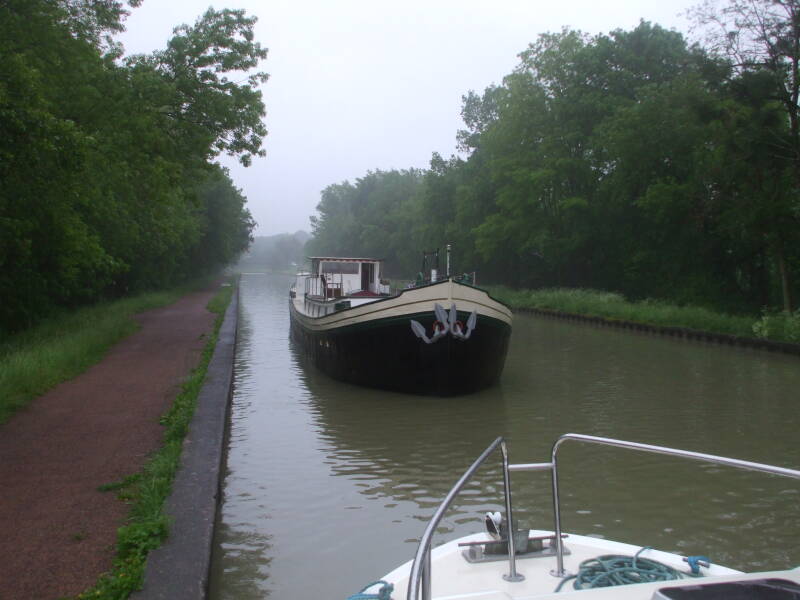
On the second trip, when it was very dark and raining, we passed through the locks and across the canal bridge to get across before the lock keeper took his lunch break. We tied up on the other side and walked back to get lunch.
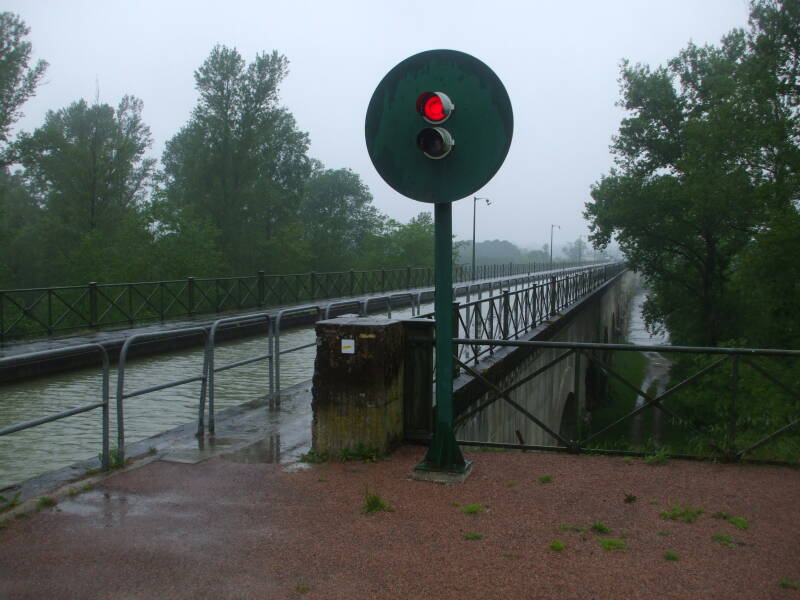
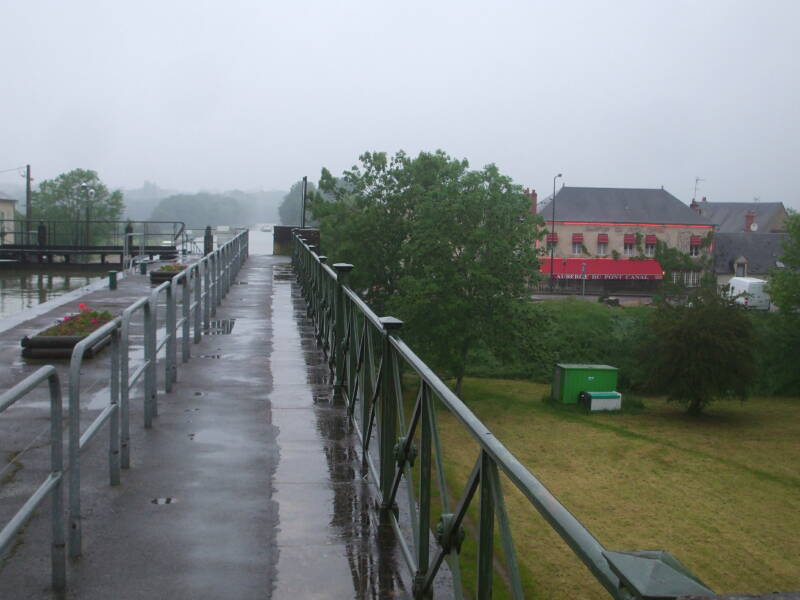
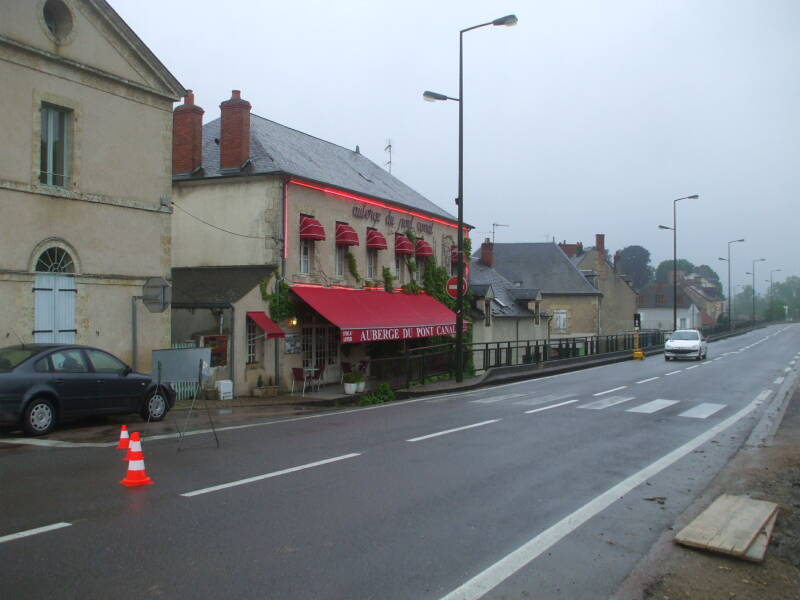
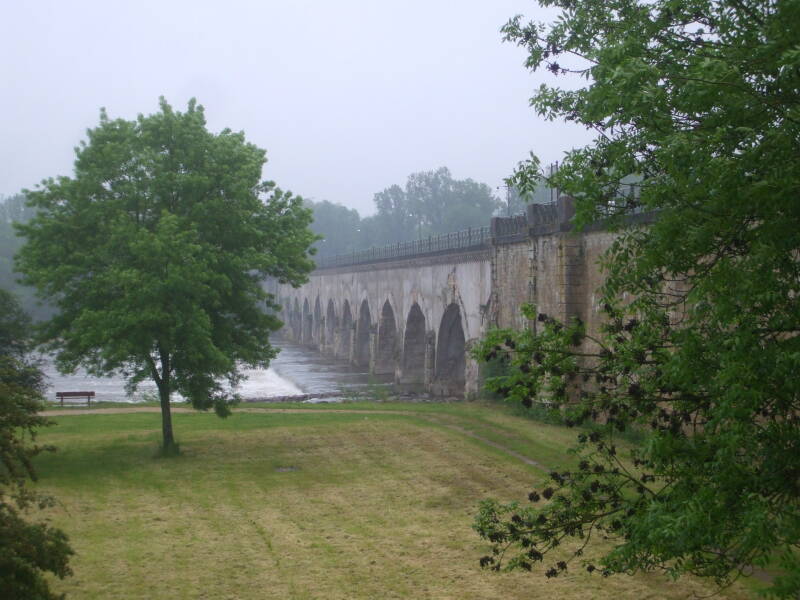
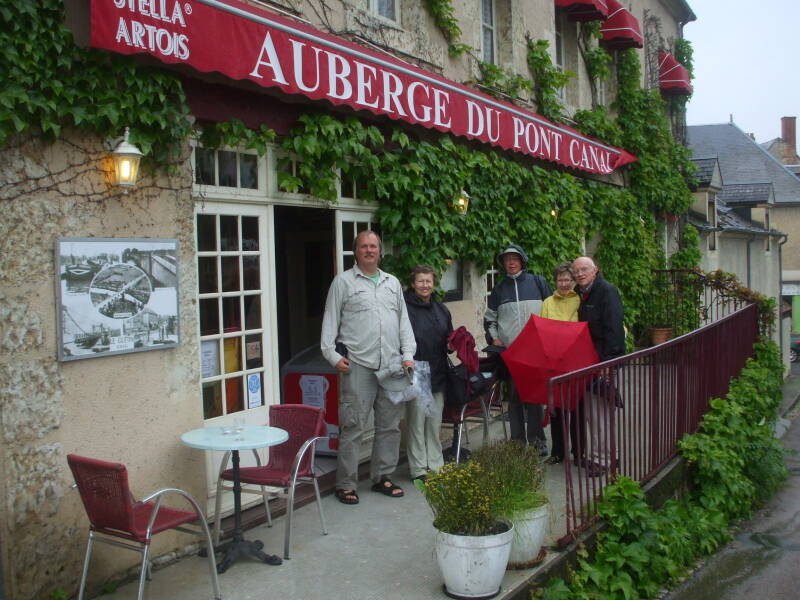
Now to cycle through the double lock and cross the canal bridge.
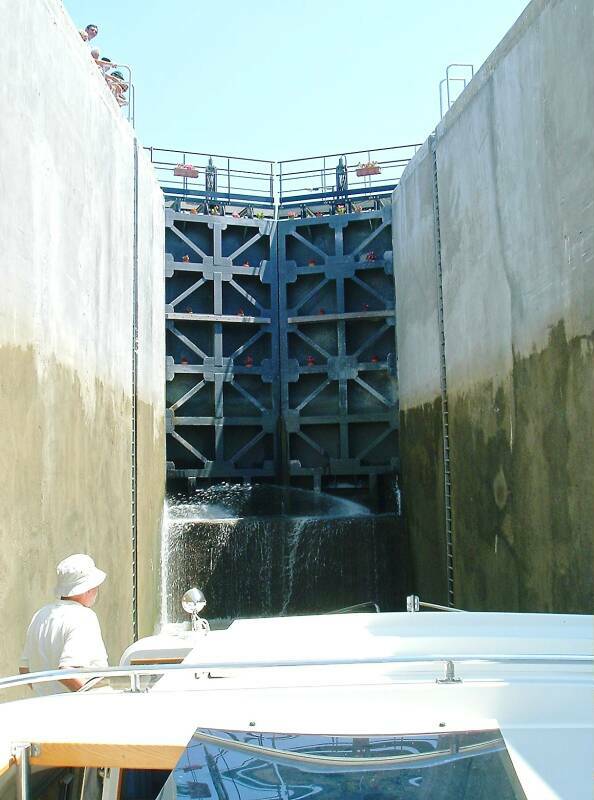

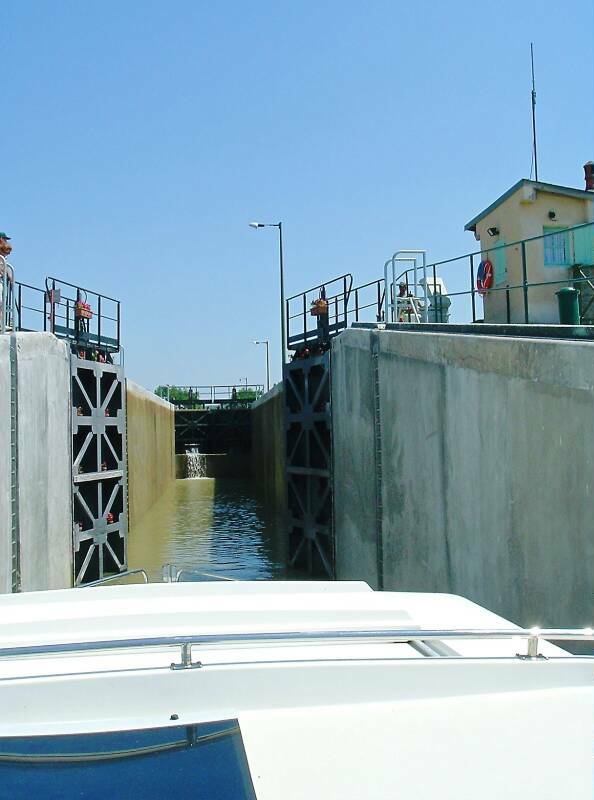
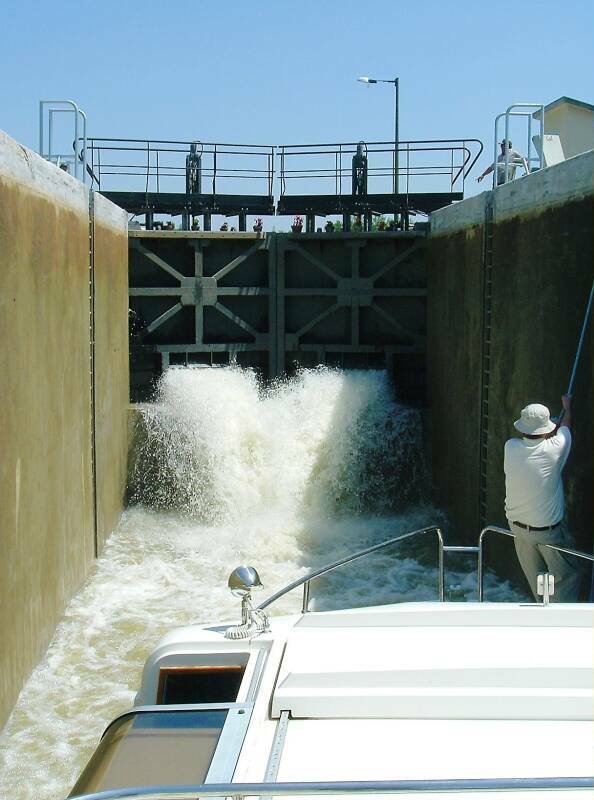
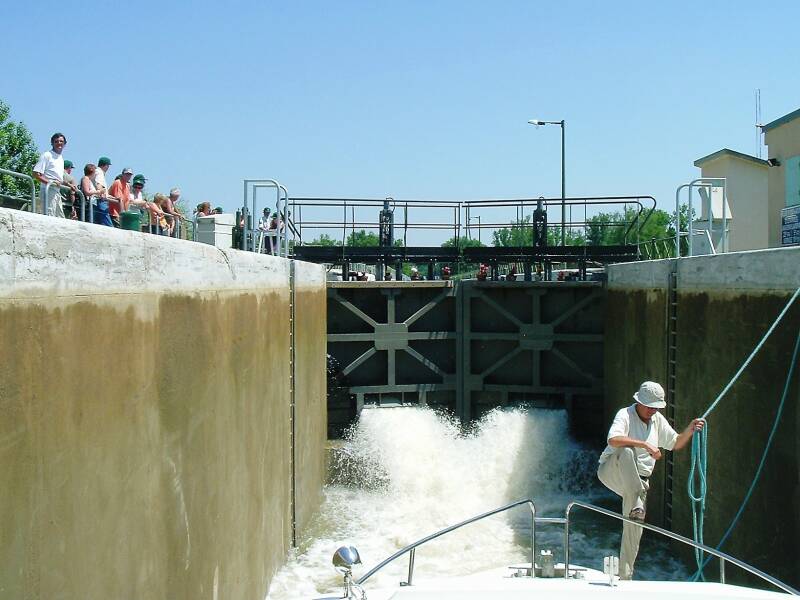
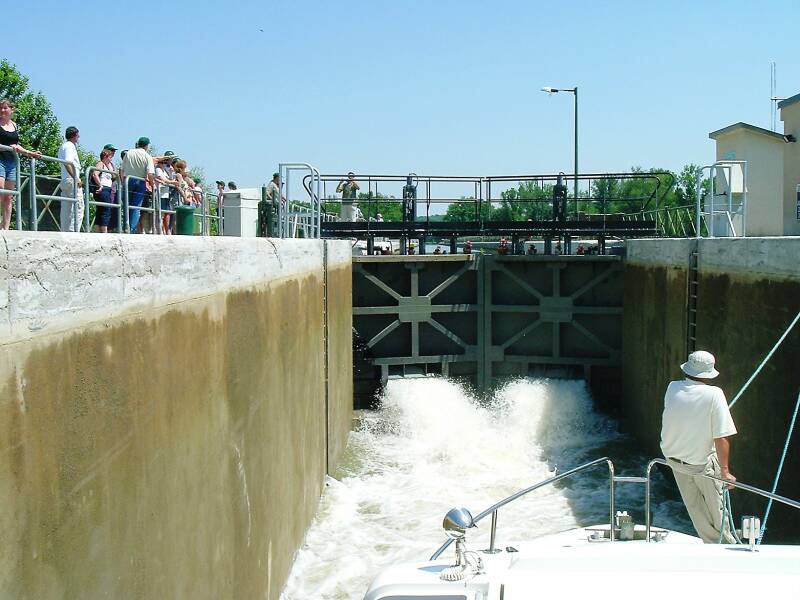
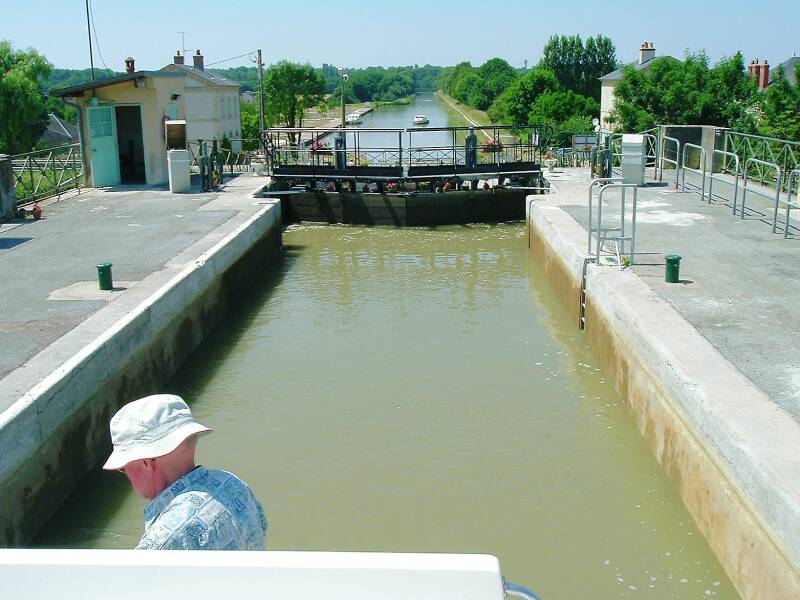

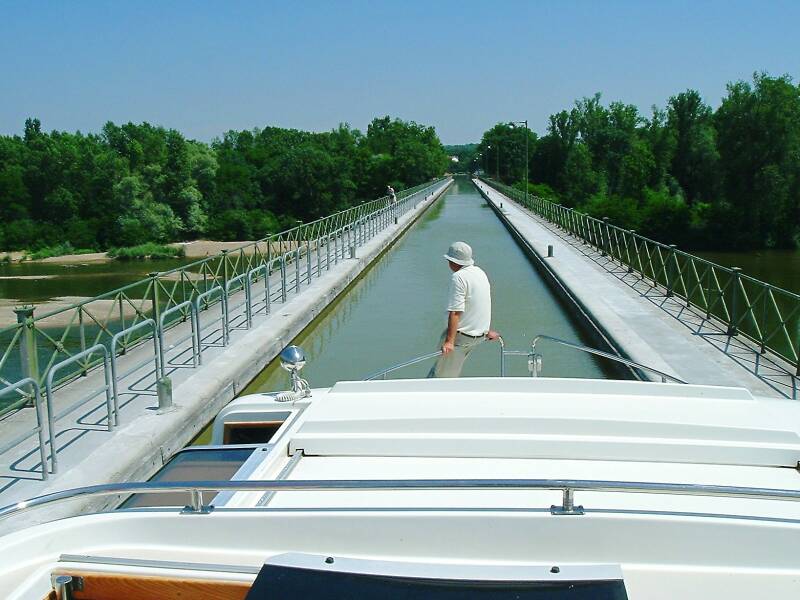
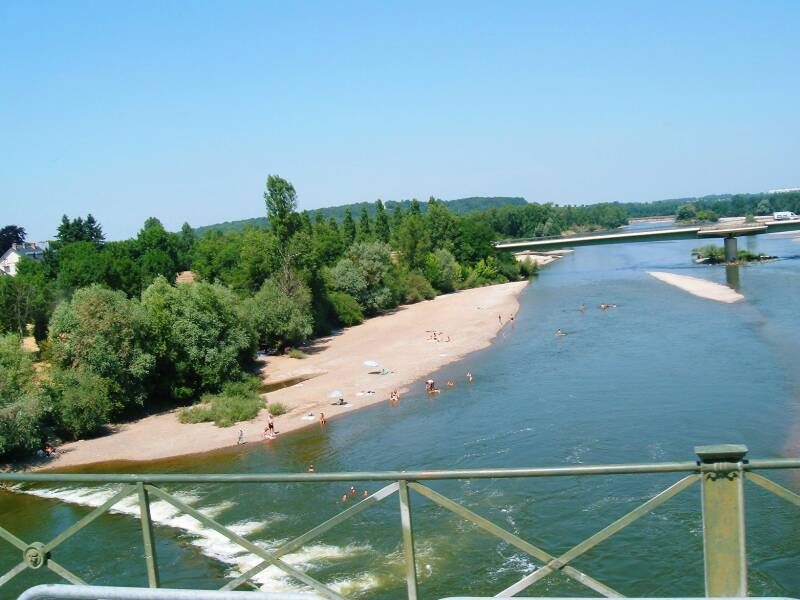
Gimouille
More onGimouille
Gimouille was called Gimollis in the Latin-centric Middle Ages, as it was named for a Roman veteran Gemollus who was granted the territory by Caesar. Its Church of Saint Lawrence was built in the 12th century.
About 460 people live here now.
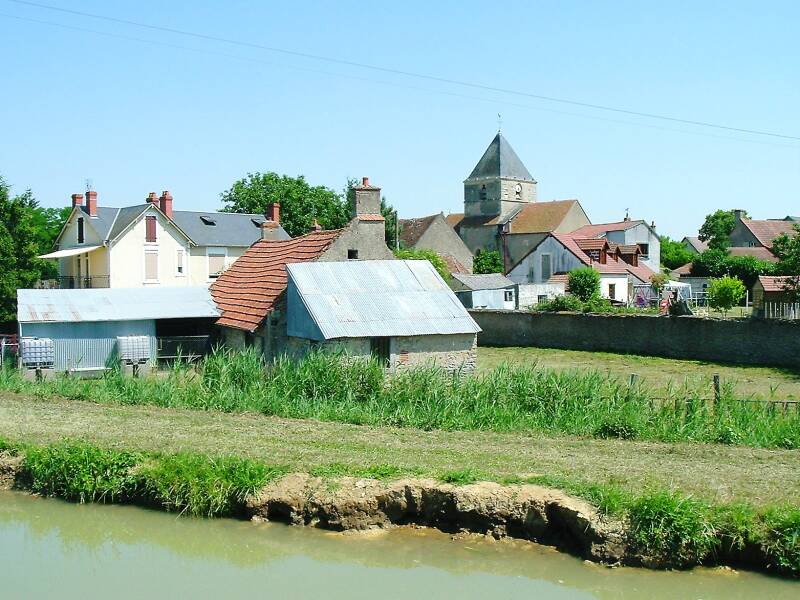
Challuy
More onChalluy
Challuy is a town of about 1,500, a few kilometers south of Nevers along the D907 highway. You could tie up here for the night where the canal broadens into a small boat basin. You could get a light dinner at the small café seen below. But it's better to continue another two to three kilometers and turn off into the side channel, continuing north to the large basin at Never.
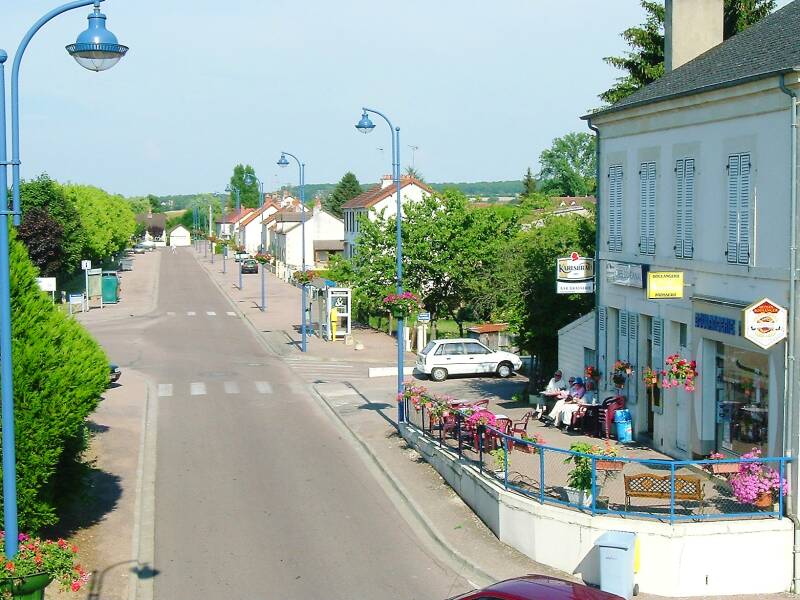
Nevers
More onNevers
East of Challuy a side channel turns off the main canal. You enter it through an electrically controlled lock, an unusual feature on this canal.
We are approaching Never, a city known for its ceramic trade since the late 16th century. Raw materials of clay and marl (or mudstone) are available locally. Surrounding forests provided wood fuel for the kilns. The Loire river provided transport, and the side channel to the Canal Latéral à la Loire improved ship transport.
The production started with Italian style polychrome, moving on to copy Persian designs in 1630 and then Chinese designs in 1660.
Production peaked in the 17th and 18th centuries. By the 18th century consumers had come to prefer china over earthenware. However, local craftsmen continue to produce the classic designs.
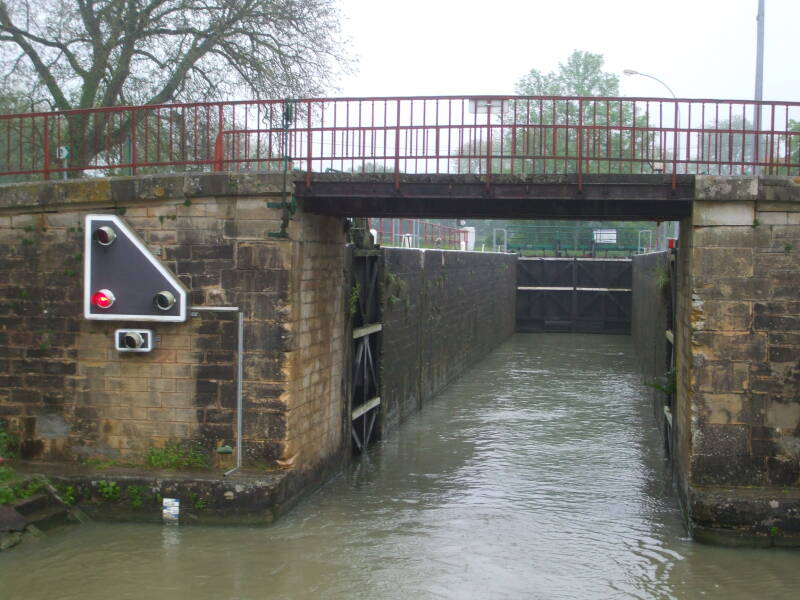
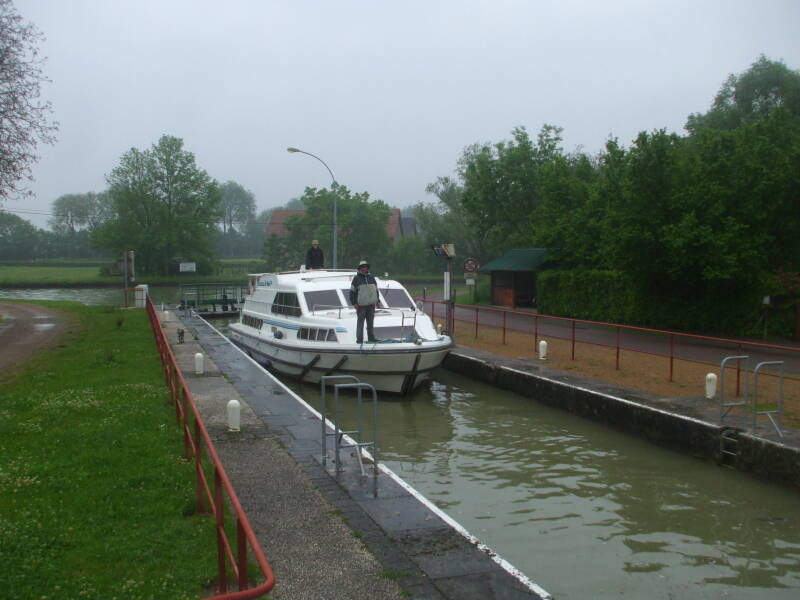

Once through the lock you enter a tree-lined canal leading a few kilometers north. The arm extending out over the canal on one side has a rope hanging down. As you are approaching the lock, if it is not set up for you, pull that rope. By the time you reach the lock, it should be about to finish automatically cycling and opening for you to enter.
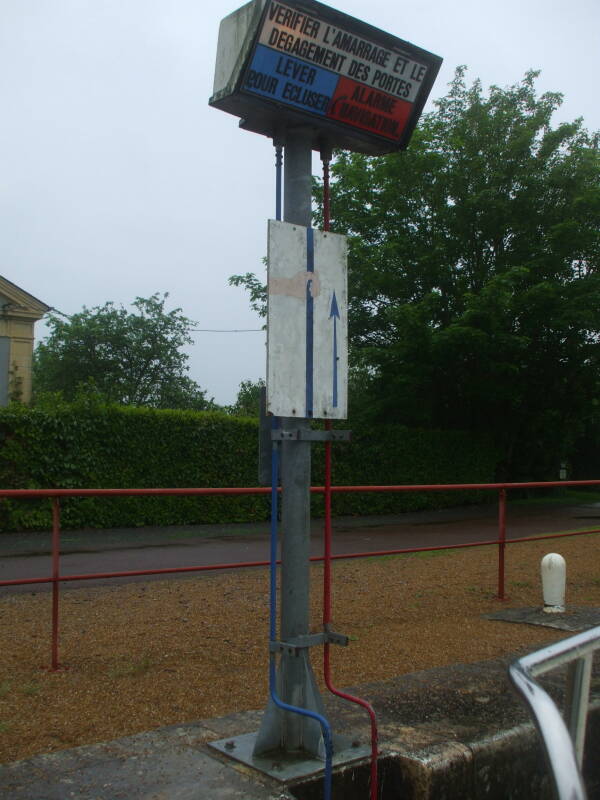
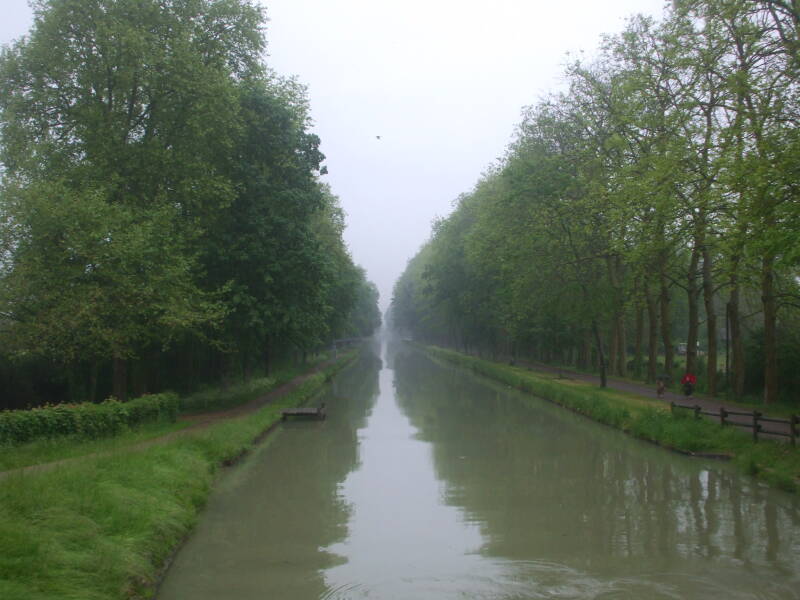
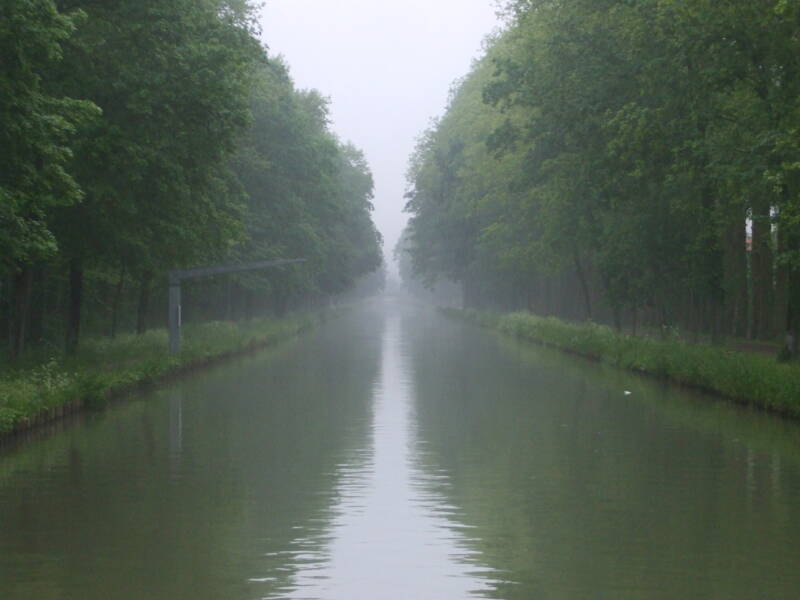
We tied up in the boat basin and walked across the Loire bridge into Nevers, a true city of a little over 35,000 people. Narrow streets wind up into the old city past houses from the 14th to the 17th century.

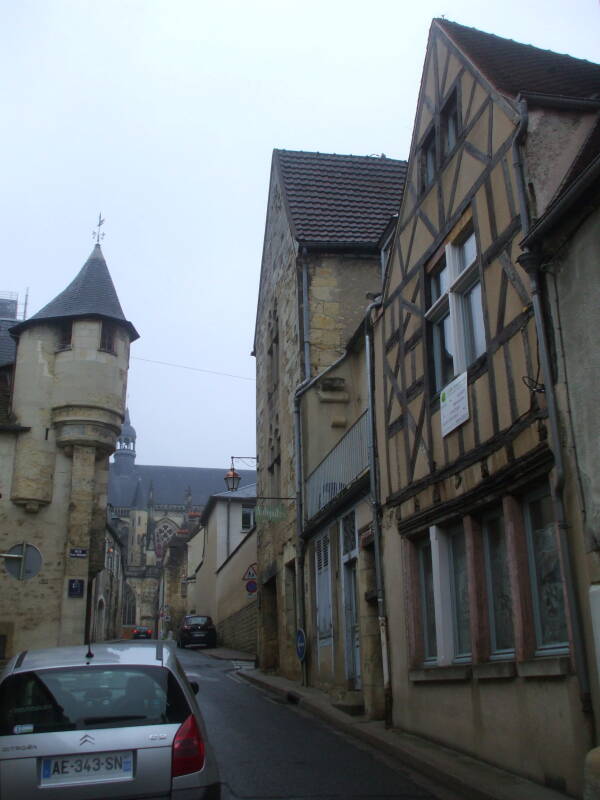
The future site of Nevers along with the rest of the territory between the Loire and the Saône was occupied by the Aedui, a Celtic people known to the Greeks as the Αἰδούοι. The Loire separated the Aedui territory from that of the Bituriges, and the Saône separated them from their adversaries, the Sequani.
The Aedui allied themselves with the Romans before Julius Caesar's time. The Sequani had defeated and massacred an Aedui army at Magetobriga. The Aedui sent their Druid representative Diviciacus to Rome to ask the Senate for assistance, but none was provided.
When Julius Caesar arrived in Gaul in 58 BC, he restored their independence. However, perhaps upset over their Druid envoy being turned down, the Aedui soon joined the Gallic alliance against Rome. That is, until they were defeated in a battle and changed back to the Roman side.
Caesar thought that this location he called Noviodunum would be a good location for a depot storing his army's food, payroll, equipment, horses, and hostages. That much made sense. He also thought that the shifty Aedui could be trusted to look after it. That was a bad idea.
When the Aedui heard of Caesar's defeat in the Battle of Gergovia in 52 BC, they massacred the non-Aedui managing the depot and the travelers who were stopped there. They divided the money and horses among themselves. They used all the available boats to load up all the grain they could, and either burned or discarded the rest in the river. Then they burned the town and left.
In later Roman times the city's name was recorded as Nevirnum, Ebrinum, and Nebirnum. By the end of the 5th century it was the seat of a bishop.

The Palais Ducal was built in the 15th and 16th century as the home of the counts and dukes of Nevres. It is one of the outstanding feudal structures in central France. It is now occupied by the city hall, part of the city's tourist office, and a museum of the local ceramics.
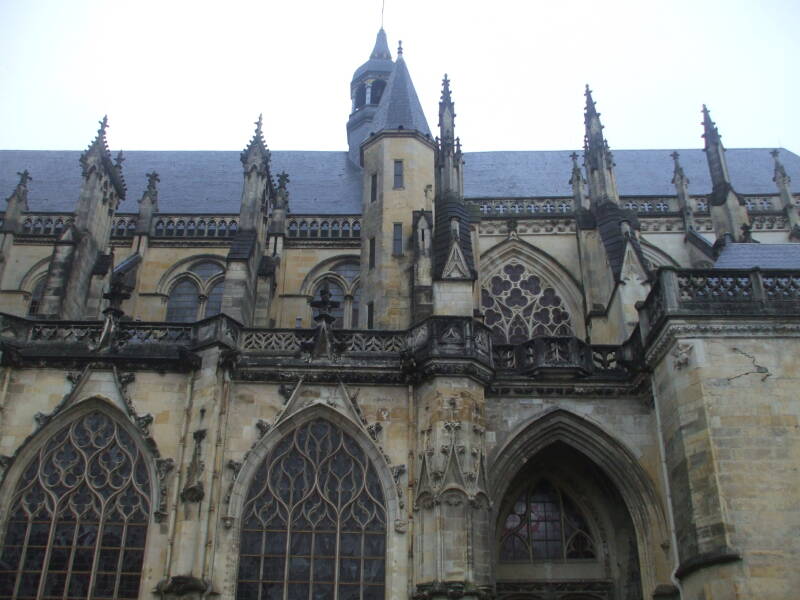
The Cathedral of Saint Cyr — Sainte Julitte is a very unusual structure. It's really two cathedrals connected back-to-back but not completely aligned. This gives it two apses or (literally) head ends and one transept. The end seen here is the later, Gothic half. The other end is based on an earlier Romanesque cathedral.
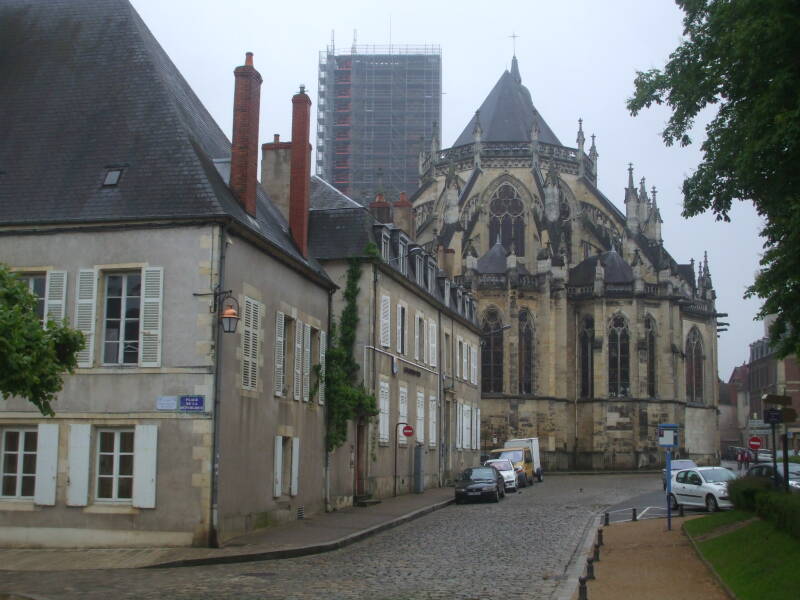
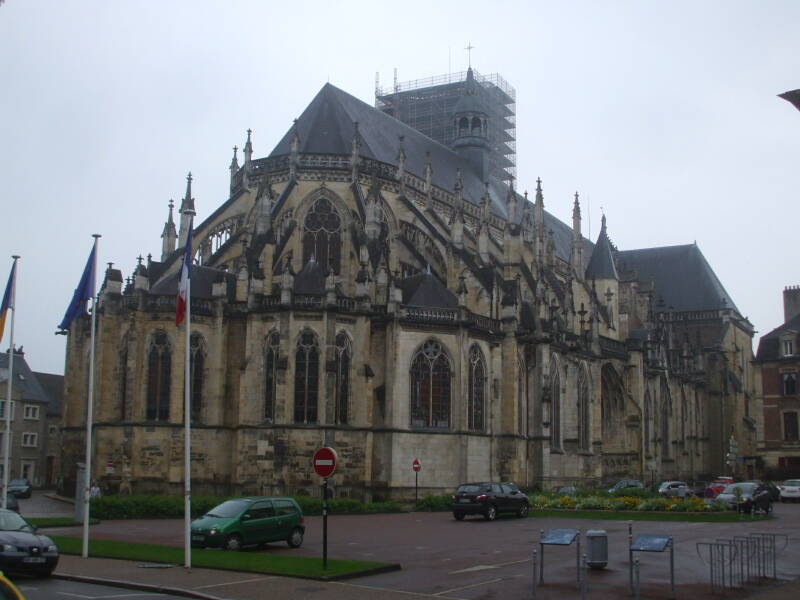
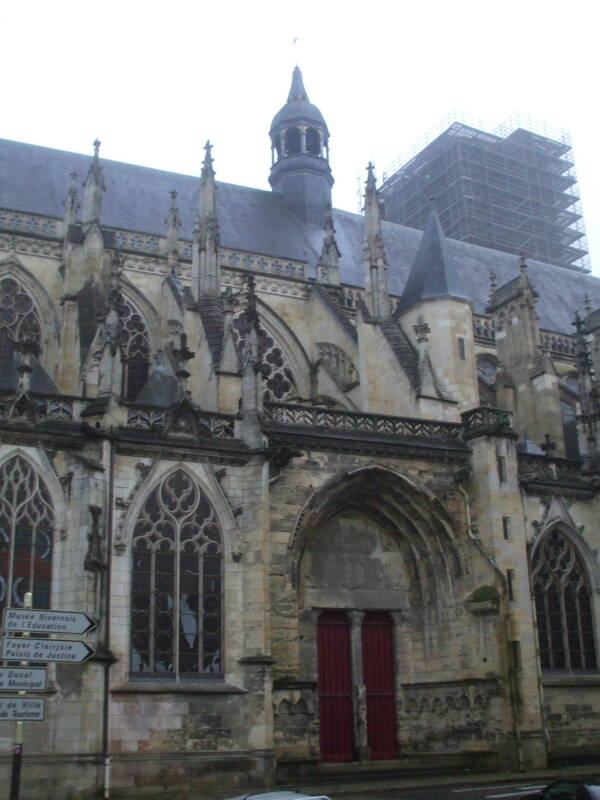
We crossed back over the Loire as the evening became more and more impressionistic. We will come back in the morning to see the cathedral's interior.

Origins of the Nevers Cathedral
A Roman temple of Janus was discovered in 1904 in the foundations of the hilltop cathedral. A bishop's seat was established here in the 6th century, and the first cathedral was built. It was initially dedicated to Saints Gervais and Protais.
The odd thing is that it was built facing the opposite of the usual direction — you entered at the east end and the altar was in the west end. This may have been a compromise putting the new cathedral over the Roman temple while keeping the main entrance out of the political center.
The usual design of a cathedral has the main entry at the west end. The overall plan is like a cross. The main space, the largest rectangular section, is the nave. The word nave comes from medieval Latin navis, meaning ship, so the nave can be visualized as a "ship of souls."
A transept extends to either side, with the roughly square intersection called the crossing.
The choir is the rectangular area beyond the crossing, before you reach the high altar in the apse.
There may be an ambulatory, a passageway around the perimeter outside the main area of the nave and the choir and apse. Radiating chapels may extend out at right angles from the ambulatory.
A chevet chapel is named for the head of a bed. The idea is that if the crucified Christ is visualized as laid out on the cross shape of the cathedral, his head would lie on the "pillow" of the chevet chapel.
Julitta and Cyr
VisitingKonya
Ὶουλίττα (or Julitta) was a recently widowed woman living in Iconium, today's Konya in Turkey, with a young son named Κηρύκος (or Cyr) who had been born around 300 AD. Julitta wanted to raise her son as a Christian, and then the Roman Emperor Diocletian issued an order for persecution of the Christians.
Julitta fled from Iconium to Seleucia, then on to Tarsus, where the Roman governor arrested her in 304. She was tortured when she refused to sacrifice to Roman idols.
According to the hagiographies, the three to five year old Cyr then repeatedly shouted that he was also a Christian. The governor said OK, let's also torture him. The torturing crew deployed their branding irons, hot oil, and whips, but found that they suffered the pain while the child felt nothing. The exasperated governor finally threw Cyr down the stairs of the court, or against the wall according to another version. Cyr was dead, and his mother cried out her thanks that God had "crowned her son with martyrdom before her." Then the Romans killed her, too.
Relics
The two martyrs became very popular. Relics attributed to them were spread within a century throughout the eastern Mediterranean, Palestine and the rest of the Levant, Pontus (the eastern Black Sea coast of today's Turkey), the Kingdom of Iberia (in the southern Caucasus in today's Georgia and not the Iberian peninsula), and Lydia in western Anatolia. Soon afterward their relics were found as far west as Italy and as far east as the Saint Kuriakose Indian Orthodox Syrian Chapel in Ayyampilly, India.
Amâtre was bishop of Auxerre in 386–418. He went to Antioch on the eastern Mediterranean coast and collected many relics of Cyr and Julitta. Amâtre gave an entire arm of Cyr to his traveling companion Savin, a monk originally from Macedonia and at the time at a monastery in western France. He distributed the rest of the relics to several churches in Tours, Chartres, and elsewhere.
By the late 8th century the Nevers cathedral was in very bad shape. The local legend is that the Emperor Charlesmagne had a dream that he was hunting and was about to be killed by a wild boar. He called out for heavenly aid, and a naked young child appeared. The child said that he would save the Emperor if he could have some clothes to cover his nakedness. The monarch agreed and handed over his cloak, and the child rode away on the boar.
Charlesmagne asked his advisors to interpret his dream. One of them was Jerome, the bishop of Nevers in 796–815. Jerome was trying to restore the cathedral following its recent re-dedication to Cyr and Julitta.
Jerome told Charlesmagne that the dream was obviously about the restoration of the cathedral of Nevers. The child was Cyr, and the cloak Charlesmagne gave to him represented the return of confiscated church property and the reconstruction of the church, especially its roof.
Charlesmagne had walked right into that one.
Charlesmagne funded the repairs to the cathedral. The Emperor's interest in the project allowed Jerome to obtain some of the relics of Cyr and Julitta from Auxerre.
Later, probably during the 841–858 term of Heriman as bishop, a major portion of Cyr's body was transferred from the Auxerre cathedral to Nevers.
During the episcopate of Tedalgrin as bishop of Nevers in 928–947, the entire bodies of both Cyr and Julitta were brought from Auxerre. This meant that Nevers now had two complete bodies and a supply of spare parts, plus there was that extra arm of Cyr that Savin had taken with him to Poitou in western France. The Frankish king Raoul, Duke of Burgundy, donated a gold reliquary to encase the head of Cyr just brought from Auxerre.
A new reliquary combining all the parts of Cyr and Julitta now collected in Never was constructed in 1594. The combined reliquary disappeared in the bombing of 1944.
Fires and Reconstruction
The original cathedral had been built in the simpler Romanesque style. A transept was built at the beginning of the 12th century.
Then a fire in 1121 destroyed much of the cathedral. The area immediately to the east of the cathedral was clear at the time, so the bishop directed the construction of a new cathedral in the Gothic style. The two cathedrals were placed back-to-back, with what would have been their entrance ends joined.
There were further fires and waves of construction through the 13th and 14th centuries. After all that, the new choir ended up slighly misaligned with the axis of the original church and the new nave. No transept was built on the newer Gothic end, but a tower was added.
A system of radiating chapels was built around the Gothic choir in the 15th century and along the nave in the 16th century. The structure had now reached an overall length of 101 meters, with a nave 22.3 meters tall.
The cathedral was plundered during the Revolution. The tombs throughout the nave were smashed, and many of the statues were either destroyed or taken away. This was followed several decades of reconstruction, much of it of poor quality.
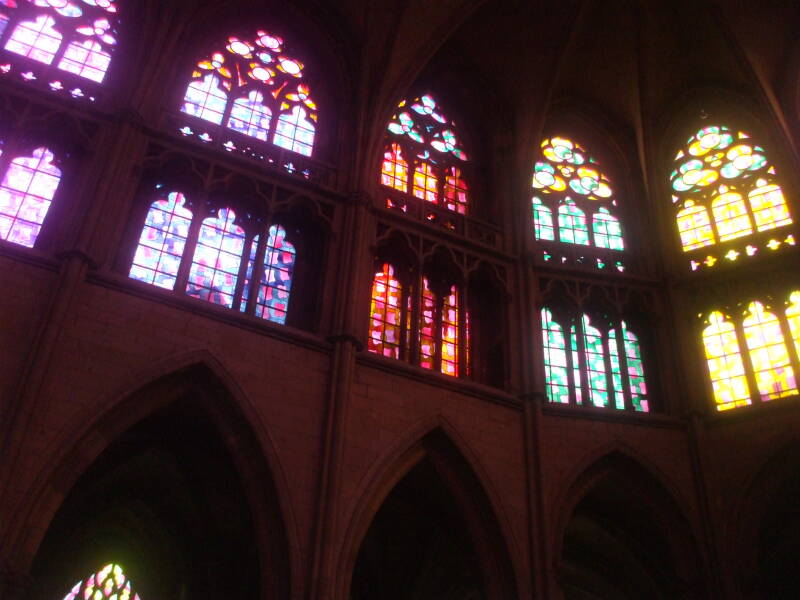
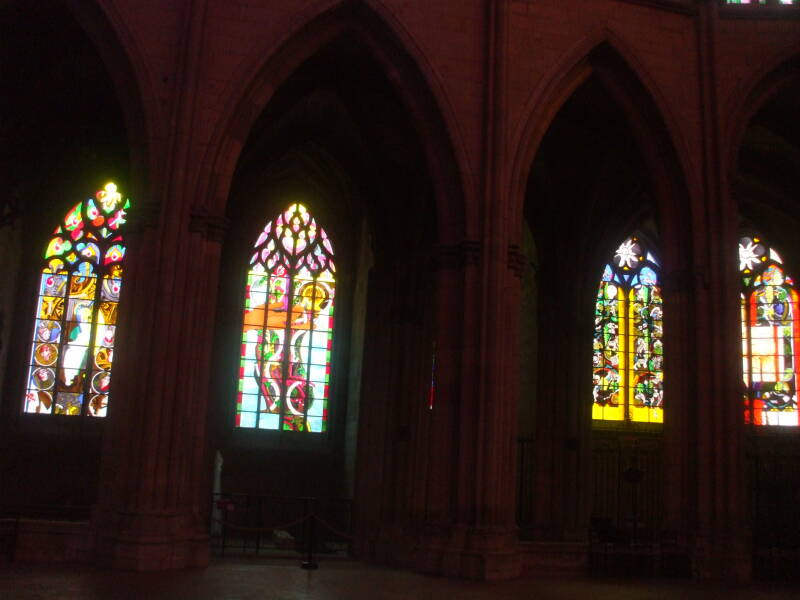
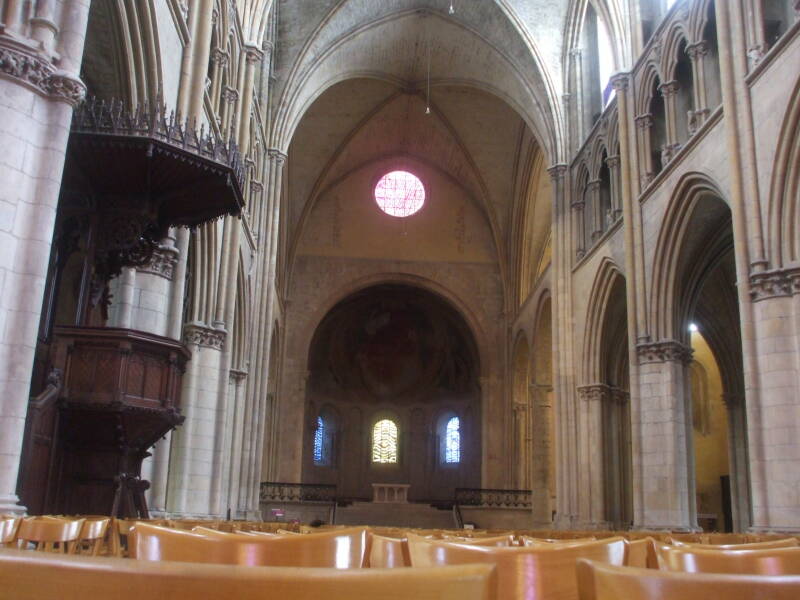
The Romanesque western apse is simple, with an almost Orthodox Χριτός Παντοκράτωρ or Christos Pantokrator, Christ in Majesty.
The Gothic eastern apse is, well, Gothic. With modern windows.
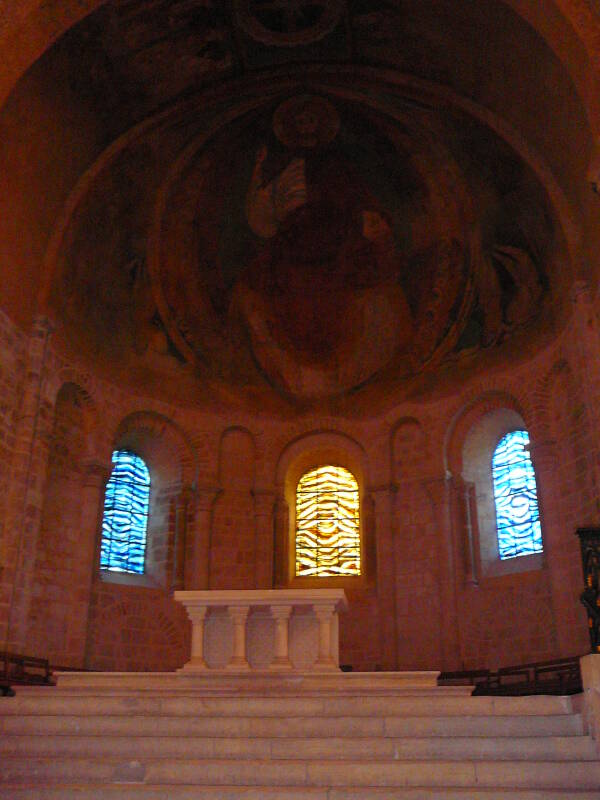

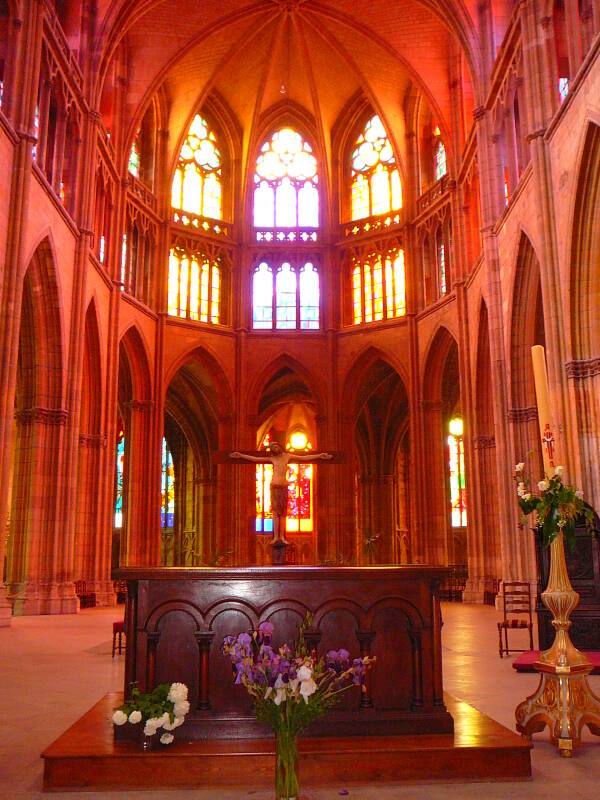
On the night of July 15–16, 1944, an Allied bombing raid targeting the rail yards accidentally hit the center of Nevers. The cathedral was nearly destroyed. The windows were all blown out, and the Gothic choir vault collapsed.
Structural reconstruction went on from 1946 through 1966. Concurrent archaeological work beneath the choir uncovered remains of a 6th century baptistry. French President François Mitterand called in 1980 for the stained glass windows to be replaced.
The stained glass project was finally completed in 2009. The replacement windows were made by six contemporary glass artists.
After the early morning visit to the cathedral, we returned to our boat and got back on the canal.


